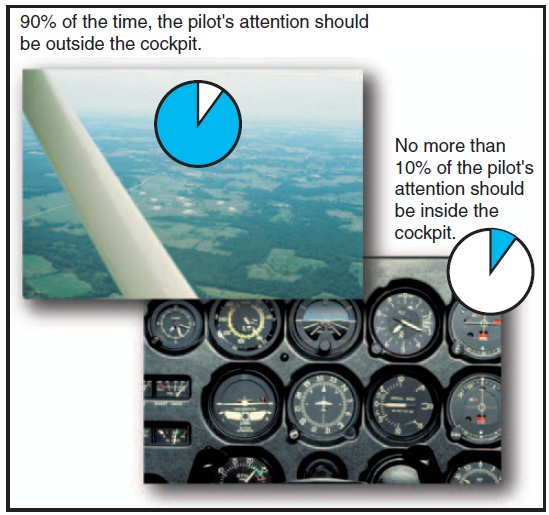
Chapter 3—Basic Flight Maneuvers
Table of Contents
The Four Fundamentals
Effects and Use of the Controls
Feel of the Airplane
Attitude Flying
Integrated Flight Instruction
Straight-and-Level Flight
Trim Control
Level Turns
Climbs and Climbing Turns
Normal Climb
Best Rate of Climb
Best Angle of Climb
Descents and Descending Turns
Partial Power Descent
Descent at Minimum Safe Airspeed
Glides
Pitch and Power

INTEGRATED FLIGHT INSTRUCTION
When introducing basic flight maneuvers to a beginning pilot, it is recommended that the “Integrated” or “Composite” method of flight instruction be used. This means the use of outside references and flight instruments to establish and maintain desired flight attitudes and airplane performance. [Figure 3-2] When beginning pilots use this technique, they achieve a more precise and competent overall piloting ability. Although this method of airplane control may become second nature with experience, the beginning pilot must make a determined effort to master the technique. The basic elements of which are as follows.

Figure 3-2. Integrated or composite method of flight instruction.
- The airplane’s attitude is established and maintained by positioning the airplane in relation to the natural horizon. At least 90 percent of the pilot’s attention should be devoted to this end, along with 90% of the time, the pilot's attention should be outside the cockpit. scanning for other airplanes. If, during a recheck of the pitch and/or bank, either or both are found to be other than desired, an immediate correction is made to return the airplane to the proper attitude. Continuous checks and immediate corrections will allow little chance for the airplane to deviate from the desired heading, altitude, and flightpath.
- The airplane’s attitude is confirmed by referring to flight instruments, and its performance checked. If airplane performance, as indicated by flight instruments, indicates a need for correction, a specific amount of correction must be determined, then applied with reference to the natural horizon. The airplane’s attitude and performance are then rechecked by referring to flight instruments.
- The pilot then maintains the corrected attitude by reference to the natural horizon.
- The pilot should monitor the airplane’s performance by making numerous quick glances at the flight instruments. No more than 10 percent of the pilot’s attention should be inside the cockpit.
- The pilot must develop the skill to instantly focus on the appropriate flight instrument, and then immediately return to outside reference to control the airplane’s attitude.
The pilot should become familiar with the relationship between outside references to the natural horizon and the corresponding indications on flight instruments inside the cockpit. For example, a pitch attitude adjustment may require a movement of the pilot’s reference point on the airplane of several inches in relation to the natural horizon, but correspond to a small fraction of an inch movement of the reference bar on the airplane’s attitude indicator. Similarly, a deviation from desired bank, which is very obvious when referencing the wingtip’s position relative to the natural horizon, may be nearly imperceptible on the airplane’s attitude indicator to the beginning pilot.
The use of integrated flight instruction does not, and is not intended to prepare pilots for flight in instrument weather conditions. The most common error made by the beginning student is to make pitch or bank corrections while still looking inside the cockpit. Control pressure is applied, but the beginning pilot, not being familiar with the intricacies of flight by references to instruments, including such things as instrument lag and gyroscopic precession, will invariably make excessive attitude corrections and end up “chasing the instruments.” Airplane attitude by reference to the natural horizon, however, is immediate in its indications, accurate, and presented many times larger than any instrument could be. Also, the beginning pilot must be made aware that anytime, for whatever reason, airplane attitude by reference to the natural horizon cannot be established and/or maintained, the situation should be considered a bona fide emergency.
PED Publication